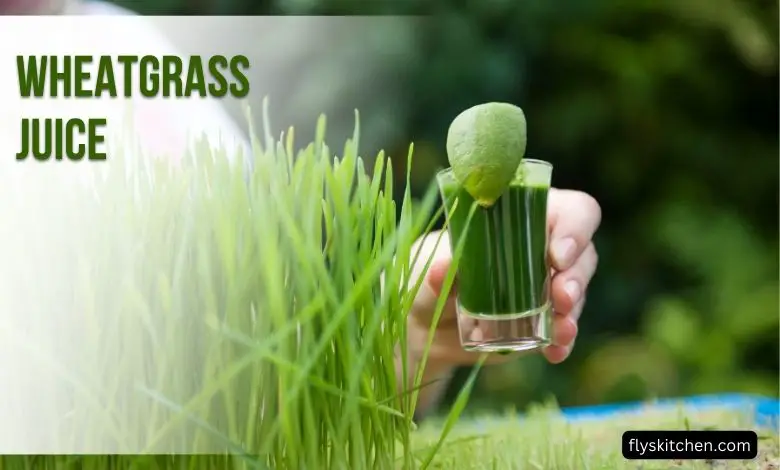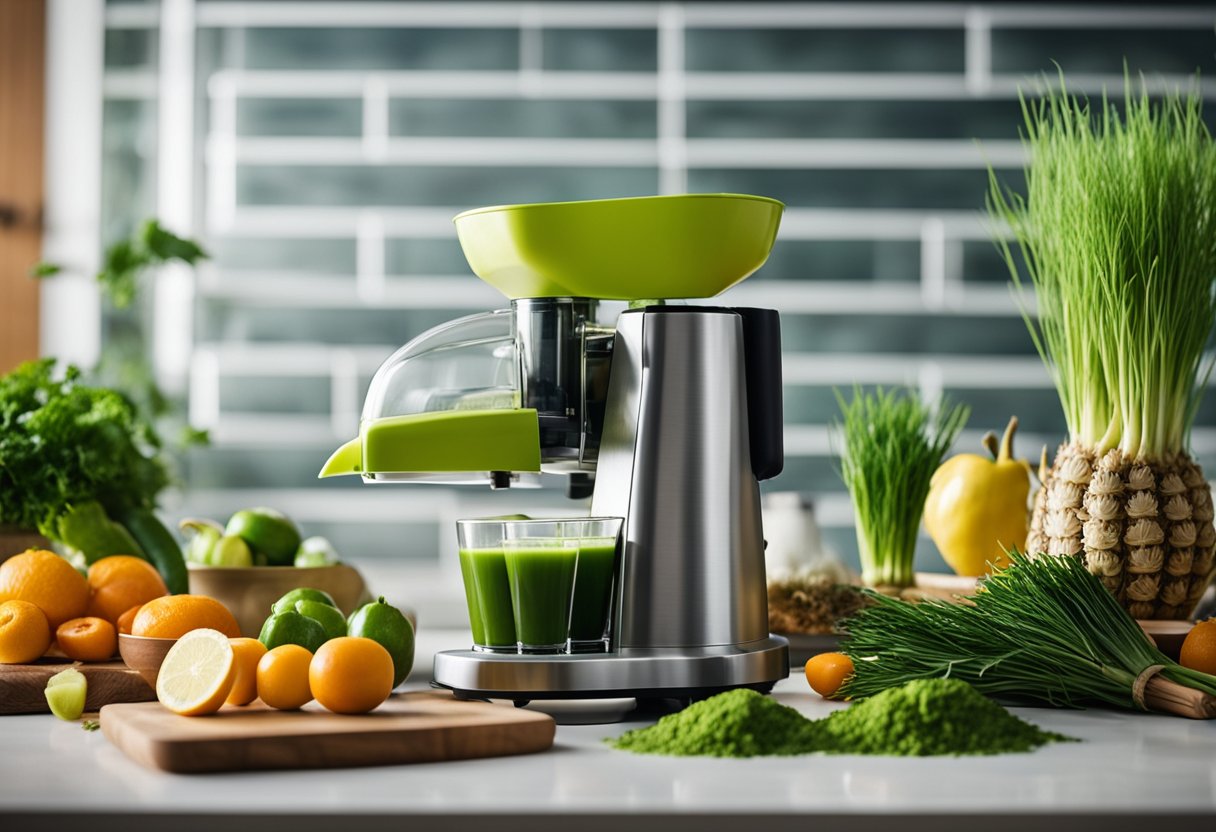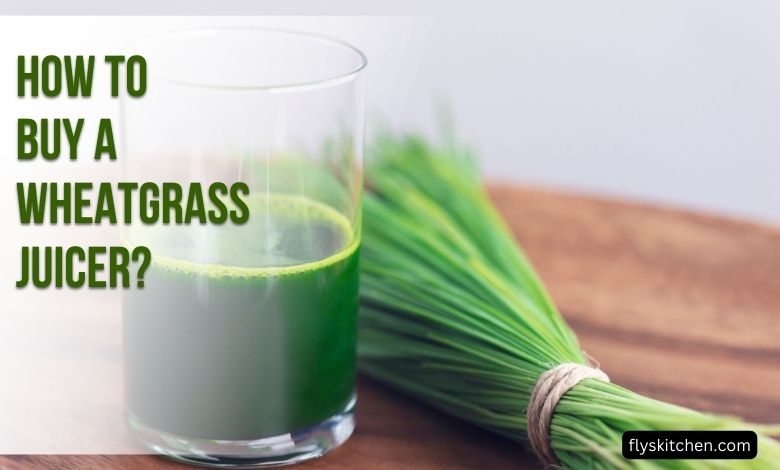Wheatgrass juice has become a major health craze in recent years, prized for its concentrated nutrients, antioxidants, and enzymes that deliver a wide range of benefits. Wheatgrass is the young grass shoots of the wheat plant, harvested before maturity. This superfood is packed with vitamins, minerals, and amino acids that provide an immune boost, aid digestion, detoxify the body, and increase energy levels.
To properly extract all these nutrients and enzymes from the fibrous wheatgrass plant, a specialized appliance is required – the wheatgrass juicer. These juicers are solely designed to break down the cell walls and derive the maximum amount of juice from wheatgrass.
With wheatgrass juicing on the rise, there are now many different wheatgrass juicer models on the market with varying features. Choosing the right wheatgrass juicer suited to your needs can be challenging. This definitive guide will walk you through the key considerations when investing in a wheatgrass juicer. You’ll learn about the different types of juicers, and which features matter most, and get recommendations of top-rated wheatgrass juicers to choose from. Let’s explore how to select the perfect wheatgrass juicing appliance to become a regular part of your health regimen.
Contents
Why Drink Wheatgrass Juice?

Wheatgrass is the young grass shoots of the wheat plant, harvested before it reaches full maturity. It contains high concentrations of nutrients, antioxidants, and enzymes that provide a wide range of potential health benefits:
- Improves immunity – Wheatgrass is packed with vitamin C, vitamin E and selenium. This nutrient trio helps boost the immune system and fight infection.
- Detoxifies the body – Wheatgrass contains enzymes like SOD (superoxide dismutase) along with nutrients like vitamin C and amino acids. Together, they help rid the body of toxins.
- Increases energy – The nutrients in wheatgrass juice get absorbed quickly into the bloodstream, giving an energy boost.
- Aids digestion – Enzymes like protease and lipase in wheatgrass improve digestion and nutrient absorption.
- Fights inflammation – Wheatgrass has anti-inflammatory properties that can help reduce swelling and relieve pain.
- Improves cardiovascular health – The iron and amino acids in wheatgrass promote circulation and oxygenation of the blood.
Given the many evidenced-based benefits, drinking wheatgrass juice regularly can be a major boost to your overall health, vitality and immunity. Now let’s look at the key considerations when choosing a wheatgrass juicer.
Types of Wheatgrass Juicers
There are three main types of wheatgrass juicers to choose from:
Manual Hand Crank Juicers
This is the original style of wheatgrass juicers. It consists of a simple hand crank assembly and a grinder. To operate it, you feed wheatgrass into the chute and turn the handle which grinds and presses the grass, extracting juice through the strainer.
Pros:
- Compact and lightweight
- Ideal for juicing small amounts of wheatgrass
- Simple to use
- No electricity required
Cons:
- Time consuming to juice larger amounts
- Upper body strength required to crank
- Grass can get jammed and require cleaning during juicing
Centrifugal Juicers
These electric juicers operate at high speeds, using centrifugal force to separate the pulp and juice. The wheatgrass is fed through a chute and shredded by cutting blades. The juice gets spun out through fine screens into a collection container.
Pros:
- Fast juicing, especially for large quantities
- Limited prep work required
- Easy to use and clean
Cons:
- Noisy operation
- Exposes juice to heat and air which reduces enzyme potency
- Not as efficient at juicing leafy greens like wheatgrass
Cold Press Juicers
Cold press juicers, sometimes referred to as masticating juicers, crush and press the wheatgrass at slow speeds to squeeze out its juice. This generates little friction and heat, protecting nutrient quality.
Pros:
- Preserves enzymes and allows minimal oxidation
- Versatile for juicing wheatgrass, leafy greens, fruits and vegetables
- Quiet operation
- Cold pressed juice can be stored up to 72 hours
Cons:
- Slower juicing speeds
- Higher price points
- More parts and accessories to clean
Based on how you plan to use your wheatgrass juicer and your budget, you can narrow down the field by juicer type. Cold press juicers are the top choice for maximum extraction and juice quality but they come at a higher cost. Centrifugal juicers offer speed and convenience if you’re making wheatgrass juice in larger amounts. Manual juicers provide an affordable option for occasional use.

Key Features to Look for in Wheatgrass Juicers
Beyond deciding on the type of juicer, here are some specific features to evaluate:
Chute Size
The chute or feed tube is where you insert the wheatgrass into the juicer. The average size is 1 to 1.5 inches in diameter. Some models have larger chutes closer to 3 inches wide. A wider chute means less prep work of chopping wheatgrass into small pieces before juicing.
Juice Yield
Check the juice yield or efficiency to determine how much juice you can expect from the wheatgrass. Masticating cold press juicers tend to have 50-80% efficiency compared to 35-50% for centrifugal juicers. Higher juice extraction means you get more of the nutritious benefits.
Pulp Ejection
An auto-eject function for disposing of the pulp saves added clean-up time. Juicers that eject pulp into an external container are more user-friendly.
Speeds
For centrifugal juicers, higher speeds produce juice faster. But speeds over 5,000 RPM can aerate the juice, reducing enzyme potency. Cold press juicers operate at 80-120 RPM to preserve nutrients.
Feed Chute Style
Vertical feed chutes can accommodate larger amounts of produce without needing to push it through the juicer. Horizontal feed chutes may have a smaller footprint.
Safety Features
Look for safety features like sensors that automatically stop operation if the cover is removed, or feet that prevent sliding. This prevents accidents and juice messes.
Easy to Clean
Consider how many parts need to be cleaned after juicing and if they are dishwasher safe. Too many nooks and crannies can make cleaning difficult.
Warranty
More expensive juicers should come with a warranty of 10 years or longer, covering the motor and parts. Basic models may have just 1-3 year warranties.
Budget
Juicer prices range widely from $50 to $400 or more. High-powered commercial juicers with maximum extraction can cost over $2,000 but are overkill for home use. Set a budget and look for the best value based on the performance factors above.
Additional Accessories
Some juicers come with handy extras like cleaning brushes, receptacles for pulp collection, juice jugs, and recipe books. This adds value for the price.
Top 5 Wheatgrass Juicers
Based on the criteria above, below are 5 of the top-rated wheatgrass juicers currently available at different price points.
- Breville JE98XL Juice Fountain Plus – Centrifugal – 850 Watts motor, extra wide 3” feed chute, stainless steel micro mesh filter, 6,500 RPM, auto pulp ejection – Under $150
- Mueller Austria Juicer Ultra – Cold Press – 1,100-watt motor, 3” chute, slow 60 RPM, quiet operation, bonus cleaning brush – Under $120
- Tribest GSE-5000 Greenstar Elite – Cold Press – Magnetic twin gears, 200 RPM, 50-55% juice yield, automatically ejects pulp, 12-year warranty – Under $500
- Omega NC900HDC – Cold Press – 150-watt motor, 80 RPM, high juice yield, adjustable 5 settings, 15-year warranty – Under $350
- Lexen GP27 Manual – Manual – Chrome grinder, suction base for stability, easy twist assembly, dishwasher safe, pocket-sized – Under $100
This covers a selection of electric and manual juicers with crucial efficiency and convenience features at different price points under $500. Visit their product listings for full details and more customer reviews.
What to Juice with Your Wheatgrass Juicer?
While their name implies wheatgrass juicers are built for juicing primarily wheatgrass, they can also handle a range of other fruits, vegetables and leafy greens. Here are some additional healthy produce items you can juice with a wheatgrass juicer:
- Leafy greens – kale, spinach, parsley, celery, lettuce, cabbage, swiss chard
- Herbs – cilantro, basil, dill, mint
- Sprouts – alfalfa, broccoli, radish, clover
- Fruits – apples, lemons, limes, oranges, watermelon, pineapple
- Vegetables – carrots, beets, tomatoes, cucumber, fennel
- Roots – ginger, turmeric
Mix and match to create your own refreshing juice blends. You’ll maximize the versatility of your wheatgrass juicer by juicing diverse produce beyond just wheatgrass.
Helpful Tips for Using Your Wheatgrass Juicer
Follow these tips to get the most out of your wheatgrass juicing:
- Only use fresh, dry wheatgrass. Don’t juice frozen or wilted grass.
- Cut wheatgrass to fit feed chute to minimize jamming or clogging.
- Alternate pushing produce through with a mixer like apple or lemon to improve extraction.
- Drink wheatgrass juice immediately after juicing to get full enzyme potency.
- Store juice in airtight container in fridge up to 3 days and freeze for longer duration.
- Rinse and clean juicer parts promptly after use for easiest cleanup.
- Refer to manufacturer’s manual for model-specific cleaning recommendations.
- Replace parts like filters and blades periodically for maximum performance.
Frequently Asked Questions
Here are some common questions when shopping for a wheatgrass juicer:
Q: How much wheatgrass juice should I drink per day?
A: About 2-4 ounces of wheatgrass juice is recommended as a daily dose. Start with small amounts like 1 ounce to allow your body to adjust.
Q: Can you juice wheatgrass in a regular juicer or blender?
A: Due to its fibrous nature, wheatgrass is best juiced using a masticating or cold press juicer to fully break down and extract the juice. Centrifugal and high-speed blenders won’t be as efficient.
Q: What is the best way to grow wheatgrass for juicing?
A: Wheatgrass grows well indoors in wide, shallow trays filled with soil and kept moist. Provide light and air circulation. Cut when it reaches 4-6 inches tall before the grass shoots joint.
Q: How long does wheatgrass juice last if refrigerated?
A: For maximum freshness and enzyme activity, drink wheatgrass immediately. It can be refrigerated 3-5 days and retain nutrients but may start to degrade in flavor and color.
Q: Can you freeze wheatgrass juice?
A: Freezing in an airtight container can preserve enzymes and freshness for 4-6 months. Thaw in the fridge before drinking as texture and potency will diminish over time.
Choosing a wheatgrass juicer tailored to your needs and lifestyle is key to enjoying all the benefits of wheatgrass juice. Consider the performance features that matter most like juice extraction method, efficiency, speed, ease of use and cleanup. Comparing multiple models in your budget will help you invest in a wheatgrass juicer that you’ll enjoy for years to come.
Conclusion
Wheatgrass juicers are a great addition to any healthy lifestyle. They allow you to extract the nutrients from wheatgrass in an efficient and easy way. However, with so many options on the market, it can be overwhelming to choose the right one. In this article, we will provide a guide on how to buy a wheatgrass juicer that fits your needs and preferences.

